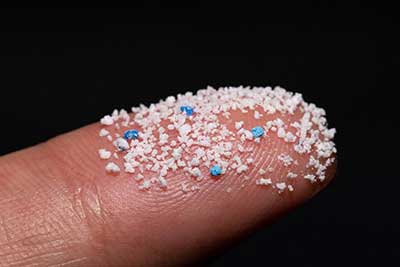Relevance: GS-3: Conservation, environmental pollution and degradation; Science and Technology - developments and their applications and effects in everyday life.
Key Phrases: Microplastics, plastic pollution, PET, polyethylene, polymers of styrene, poly (methyl methylacrylate), human health risk assessment, blood stream.
Why in News?
- Scientists have discovered microplastics in human blood for the first time, warning that the ubiquitous particles could also be making their way into organs.
Key Points:
- A study by researchers from the Netherlands (Heather A. Leslie et al, Environment International, Published online 24 March) has examined blood samples of 22 persons, all anonymous donors and healthy adults, and found plastic particles in 17 of them.
- The study was funded by the Netherland’s Organisation for Health Research and Development as well as Common Seas, a UK-based group aimed at reducing plastic pollution.
- The study found in each donor, on average, 1.6 microgram of plastic
particles per milli litre of blood sample.
- The size of the particles that the group looked for was as small as about 700 nanometres (equal to 0.0007 millimetres).
- The study looked at the most commonly used plastic polymers.
- These were polyethylene tetraphthalate (PET), polyethylene (used in making plastic carry bags), polymers of styrene (used in food packaging), poly (methyl methylacrylate) and poly propylene.
- They found a presence of the first four types.
- A report on this work, published in The Guardian conveys that
about half of these were PET (polyethylene tertraphthalate) plastics, which
is used to make food grade bottles.
- The study found that 77% of tested people (17 of the 22 persons) carried various amounts of microplastics above the limit of quantification.
- In 50% of the samples, the researchers detected PET particles; in 36%, they found presence of polystyrene, 23% of polyethylene and 5% of poly(methyl methylacrylate) were also found.
- However, traces of poly propylene were not detected.
- The study said the microplastics could have entered the body by many routes: via air, water or food, but also in products such as particular toothpastes, lip glosses and tattoo ink.
-
Microplastics are tiny bits of various types of plastic found in the environment. The name is used to differentiate them from “macroplastics” such as bottles and bags made of plastic.
-
There is no universal agreement on the size that fits this bill — the U.S. NOAA (National Oceanic and Atmospheric Administration) and the European Chemical Agency define microplastic as less than 5 mm in length.
-
However, for the purposes of this study, since the authors were interested in measuring the quantities of plastic that can cross the membranes and diffuse into the body via the blood stream, the authors have an upper limit on the size of the particles as 0.0007 millimetre.
Significance:
- Microplastics, tiny particles of plastics, have already been found almost everywhere else on Earth, from the deepest oceans to the highest mountains as well as in the air, soil and food chain, and now in human blood.
- It is not yet clear if these microplastics can cross over from
the blood stream to deposit in organs and cause diseases.
- The authors point out that the human placenta has shown to be permeable to tiny particles of polystyrene ( 50, 80 and 24 nanometre beads).
- Experiments on rats where its lungs were exposed to polystryrene spheres (20 nanometre) led to translocation of the nanoparticles to the placental and foetal tissue.
- Oral administration of microplastics in rats led to accumulation of these in the liver, kidney and gut.
- They write in the paper that this can be interpreted as an estimate of what to expect in future studies. It is a helpful starting point for further development of analytical studies for human matrices research.
- The authors of the paper also remark that validated methods to detect
the tiny (trace) amounts of extremely small-sized (less than 10 micrometre)
plastic particles are lacking.
- Hence this study, which builds up a methods to check the same, is important.
Way Forward:
- Making a human health risk assessment in relation to plastic
particles is not easy, perhaps not even possible, due to the lack of data on
exposure of people to plastics.
- In this sense, it is important to have studies like this one.
- Owing to the small size of the participants, the study results cannot be taken as such to mould policy etc, but the power of this paper is in the method and in demonstrating that such a possibility of finding microplastics in the blood exists.
- The size of the particles found is really small and it remains to be
seen if there is a danger of such particles crossing the blood cell walls
and affecting the organs.
- Also, a larger study needs to be conducted to firm up the present findings.
Further studies have to be carried out to really assess the impact of plastics on humans.
Source: The Hindu
Mains Question:
Q. What are Microplastics? Discuss the possible health impact it can have on Human health. (150 Words).









